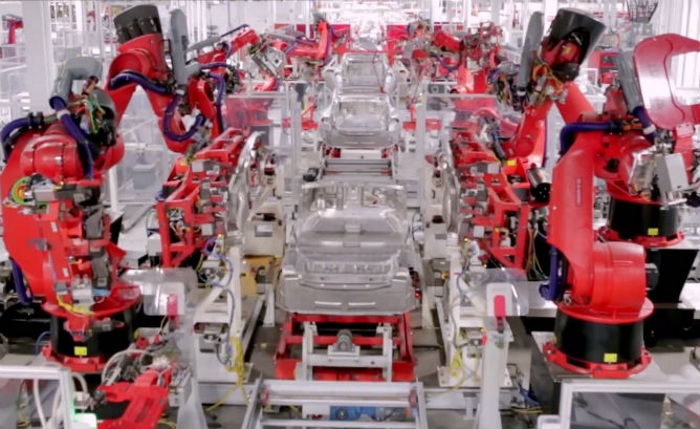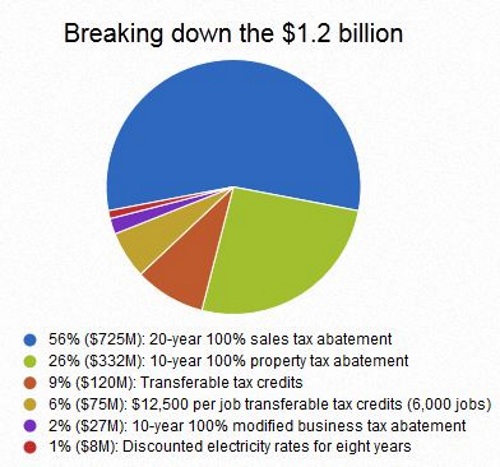In a major announcement for his state, Nevada governor Brian Sandoval said that Tesla has chosen his state as grounds for a new $5 billion factory that will produce cheaper and more efficient batteries for future cars.

Nevada governor Brian Sandoval shakes hands with Tesla CEO Elon Musk
Situated in the industrial park in Story County — roughly 15 miles east of Reno — Tesla’s “gigafactory” is expected to bring somewhere in the neighborhood of $100 billion into Nevada’s economy. Sandoval said that he hopes this target will be reached within the next 20 years.
Should the factory prove this successful, it is expected Tesla’s battery costs will be reduced by 30%.

In terms of factory development, Tesla will prepare, provide, and manage the land and buildings while Panasonic will be tasked with making and supplying the lithium-ion battery cells.
The factory is expected to create 6,500 jobs, with another 16,000 more indirectly.
Sandoval described the plant as one day becoming the “world’s largest and most advanced battery factory” and said that this was a “historic” day for his state.
In recent months, Tesla had narrowed the list of states to host its factory to Texas, California, Arizona, New Mexico, and Nevada. Elon Musk, co-founder of Tesla and its chief executive officer, said that while Nevada didn’t offer the most incentive-heavy package, it proved in its presentation that it “can do things quickly” and “get things done.”
He added that the battery factory itself “is critical to our efforts to deliver our mass-market car,” referencing the company’s forthcoming Model 3, which will start at $35,000 and travel 200 miles on an electric charge.
The $1.25 billion tax incentive package Sandoval put together in order to woo Musk to Nevada is unprecedented in size and scope for the state, and is one of the largest in the country.
Nevada: Tesla, $1.25 billion
Michigan: Chrysler, $1.3 billion
Missouri: Cerner Corp., $1.64 billion
Pennsylvania: Royal Dutch Shell, $1.65 billion
Louisiana: Cheniere Energy, $1.7 billion
New Mexico: Intel, $2 billion
Oregon: Nike, $2 billion
Washington: Boeing, $3.2 billion
New York: Alcoa, $5.6 billion
Washington: Boeing, $8.7 billion
Breaking the deal down a bit, Tesla will be able to run its gigafactory in Nevada tax-free for 10 years.

Via rgj.com
Also, the $1.25 billion this package is estimated to be worth is more than double the $500 million package Musk said would be required to draw the company.
In exchange for all of the incentives and breaks the company is receiving, Tesla must invest at least $3.5 billion in manufacturing equipment and real property in the state. But even this is considered a “softball” number, as it is significantly lower than the $10 billion state officials actually expect the company to invest over the next two decades.
Additionally, as many in the state are aware of its limited education funding, to mitigate concerns that the tax breaks the company is receiving will further deplete this division’s resources, Tesla will contribute $7.5 million per year for five years beginning in 2018 to education.
As mentioned earlier, economic development officials estimate the gigafactory, which will be three stories tall and take up about 5 million square feet of manufacturing space, will have a $100 billion economic impact on the state of Nevada over the next two decades.
“To put that into perspective, that is more than 3 percent of the state's GDP. It is more than 20 percent of the region's economic output,” said Sandoval's economic development director, Steve Hill. “What this can do for the region . . . It will allow every underemployed person to reach full employment.”
Hill added, “It will lift up everyone in the region. Property values will go up. The prosperity of the region will be materially changed.”
For the tech sector, experts estimate that once the Tesla gigafactory is fully up and running, it will be producing lithium-ion batteries at a pace faster than all of the current lithium-ion battery production in the world today.
Lastly, as a side note, especially since this relates to a recent story published on ElectronicProducts.com regarding the headache Tesla is dealing with in Georgia (specifically its auto dealers), officials added an incentive line in their proposal in which they stated Tesla will be allowed to sell cars directly to customers through a manufacturer’s store, rather than requiring an auto dealer franchise agreement.
Talk about pressing all the right buttons!
Advertisement
Learn more about Electronic Products Magazine





